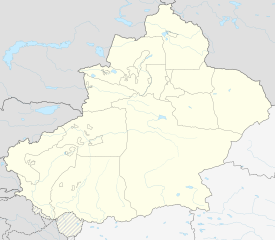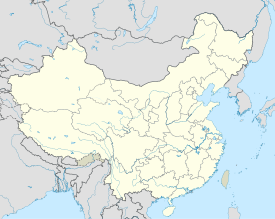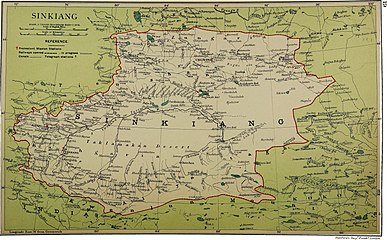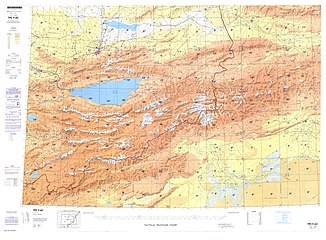Awat County
Awat County
Awati | |
|---|---|
 Location of the county in Aksu Prefecture (yellow) and Xinjiang | |
| Coordinates:40°38′00″N80°22′00″E/ 40.6333°N 80.3667°E | |
| Country | China |
| Autonomous region | Xinjiang |
| Prefecture | Aksu |
| County seat | Awat Town |
| Township-level divisions | 5towns,3townships |
| Area | |
| • Total | 13,017.89 km2(5,026.24 sq mi) |
| Population (2020)[1] | |
| • Total | 242,481 |
| • Density | 19/km2(48/sq mi) |
| Ethnic groups | |
| • Major ethnic groups | Uyghur,Han Chinese[2][3] |
| Time zone | UTC+8(China Standard[a]) |
| Postal code | 843200 |
| Website | www |
| Awat County | |||||||||||
|---|---|---|---|---|---|---|---|---|---|---|---|
| Uyghur name | |||||||||||
| Uyghur | ئاۋات ناھىيىسى | ||||||||||
| |||||||||||
| Chinese name | |||||||||||
| Simplified Chinese | A ngõa đề huyện | ||||||||||
| Traditional Chinese | A ngõa đề huyện | ||||||||||
| |||||||||||
Awat County[4][5][6][7](Uyghur:ئاۋات ناھىيىسى) is a county inAksu Prefecture,Xinjiang Uyghur Autonomous Region,China.Awat County is located on the southern foot of theTian Shanmountain range and on the northern edge of theTaklamakan Desert.[2]
History[edit]
In 1930, Awat County was established.[8]
On January 23, 2013, 474.208 km2(183.093 sq mi) of territory was transferred from Awat County toAralcity.[8]
In a 2018 report fromRadio Free Asia,Awat County was said to have threere-education camps.An RFA listener provided a copy of a "confidentiality agreement" requiring re-education camp detainees to not discuss the workings of the camps and said local residents were instructed to tell members of re-education camp inspection teams visiting No. 2 Re-education Camp, which had transferred thousands detainees and removed barbed wire from the perimeter of the camp walls, that there was only one camp in the county.[7]
During theCOVID-19 pandemic in mainland China,on February 23, 2020, 114Uyghurworkers from Awat County (Awati) were sent toJiujiang,Jiangxito resume work.[9][10]
Administrative divisions[edit]
Awat County is made up of seven towns, two townships and one other area:[2][8][11]
| Name | Simplified Chinese | Hanyu Pinyin | Uyghur(UEY) | Uyghur Latin (ULY) | Administrative division code | Notes | |
|---|---|---|---|---|---|---|---|
| Towns | |||||||
| Awat Town | A ngõa đề trấn | Āwǎtí Zhèn | ئاۋات بازىرى | Awat baziri | 652928100 | ||
| Ghoruchol Town[12] | Ô lỗ khước lặc trấn | Wūlǔquèlè Zhèn | غورۇچۆل بازىرى[13] | ghoruchöl baziri | 652928101 | formerly Ghoruchol Township (Ô lỗ khước lặc hương) | |
| Besheriq Town | Bái thập ngải nhật khắc trấn | Bàishí'àirìkè Zhèn | بەشئېرىق بازىرى | besh'ëriq baziri | 652928102 | formerly Besheriq Township (Bái thập ngải nhật khắc hương) | |
| Tamtoghraq Town | Tháp mộc thác cách lạp khắc trấn | Tǎmùtuōgélākè Zhèn | تامتوغراق بازىرى | tamtoghraq baziri | 652928103 | formerly Tamtoghraq Township (تامتوغراق يېزىسى/Tháp mộc thác cách lạp khắc hương) | |
| Yengierik Town[14][15] | Anh ngải nhật khắc trấn | Yīng'àirìkè Zhèn | يېڭىئېرىق بازىرى | yëngi'ëriq baziri | 652928104 | formerly Yengierik Township (يېڭىئېرىق يېزىسى/Anh ngải nhật khắc hương) | |
| Aybagh Town | A y ba cách trấn | Āyībāgé Zhèn | ئايباغ بازىرى | Aybagh baziri | 652928105 | formerly Aybagh Township (ئايباغ يېزىسى/A y ba cách hương) | |
| Sanhe Town | Tam hà trấn | Sānhé Zhèn | سەنخې بازىرى | senxë baziri | 652928106 | Established on 30 December 2020 | |
| Townships | |||||||
| Dolan Township[16] | Đa lãng hương | Duōlàng Xiāng | دولان يېزىسى | dolan yëzisi | 652928203 | ||
| Baytoghraq Township | Ba cách thác cách lạp khắc hương | Bāgétuōgélākè Xiāng | بايتوغراق يېزىسى | baytoghraq yëzisi | 652928204 | ||
Other areas:
- Aksu Prison (Uyghur:ئاقسۇ تۈرمىسى,A khắc tô giam ngục)
Demographics[edit]
| Year | Pop. | ±% p.a. |
|---|---|---|
| 2000 | 209,654 | — |
| 2010 | 237,562 | +1.26% |
| [8] | ||
As of 2015, 217,722 of the 262,842 residents of the county wereUyghur,42,960 wereHan Chinese,2,160 were from other ethnic groups.[17]
According to the 2002 census, it has a population of 210,000.[citation needed]
As of 1999, 81.59% of the population of Awat (Awati) County was Uyghur and 17.74% of the population was Han Chinese.[18]
Climate[edit]
| Climate data for Awat, elevation 1,044 m (3,425 ft), (1991–2020 normals, extremes 1981–2010) | |||||||||||||
|---|---|---|---|---|---|---|---|---|---|---|---|---|---|
| Month | Jan | Feb | Mar | Apr | May | Jun | Jul | Aug | Sep | Oct | Nov | Dec | Year |
| Record high °C (°F) | 8.2 (46.8) |
14.6 (58.3) |
27.8 (82.0) |
35.6 (96.1) |
36.2 (97.2) |
38.3 (100.9) |
39.0 (102.2) |
39.2 (102.6) |
34.1 (93.4) |
29.8 (85.6) |
22.1 (71.8) |
10.9 (51.6) |
39.2 (102.6) |
| Mean daily maximum °C (°F) | −0.5 (31.1) |
5.9 (42.6) |
15.0 (59.0) |
23.5 (74.3) |
28.0 (82.4) |
31.0 (87.8) |
32.0 (89.6) |
30.8 (87.4) |
27.0 (80.6) |
20.4 (68.7) |
10.5 (50.9) |
1.3 (34.3) |
18.7 (65.7) |
| Daily mean °C (°F) | −7.4 (18.7) |
−1.2 (29.8) |
7.7 (45.9) |
15.8 (60.4) |
20.3 (68.5) |
23.2 (73.8) |
24.3 (75.7) |
23.1 (73.6) |
18.5 (65.3) |
10.7 (51.3) |
2.0 (35.6) |
−5.1 (22.8) |
11.0 (51.8) |
| Mean daily minimum °C (°F) | −13.1 (8.4) |
−7.3 (18.9) |
1.1 (34.0) |
8.5 (47.3) |
13.1 (55.6) |
16.2 (61.2) |
17.6 (63.7) |
16.6 (61.9) |
11.5 (52.7) |
3.4 (38.1) |
−3.8 (25.2) |
−9.7 (14.5) |
4.5 (40.1) |
| Record low °C (°F) | −26.0 (−14.8) |
−25.0 (−13.0) |
−12.1 (10.2) |
−3.0 (26.6) |
2.2 (36.0) |
7.4 (45.3) |
8.2 (46.8) |
8.0 (46.4) |
3.3 (37.9) |
−5.5 (22.1) |
−14.1 (6.6) |
−21.9 (−7.4) |
−26.0 (−14.8) |
| Averageprecipitationmm (inches) | 1.0 (0.04) |
1.7 (0.07) |
1.6 (0.06) |
2.5 (0.10) |
9.1 (0.36) |
16.6 (0.65) |
14.8 (0.58) |
12.6 (0.50) |
9.3 (0.37) |
2.5 (0.10) |
1.0 (0.04) |
1.1 (0.04) |
73.8 (2.91) |
| Average precipitation days(≥ 0.1 mm) | 1.7 | 1.1 | 0.7 | 1.3 | 3.2 | 6.2 | 6.7 | 5.7 | 3.3 | 1.3 | 0.7 | 1.5 | 33.4 |
| Average snowy days | 5.0 | 2.4 | 0.3 | 0.1 | 0 | 0 | 0 | 0 | 0 | 0.1 | 0.7 | 4.9 | 13.5 |
| Averagerelative humidity(%) | 69 | 60 | 47 | 39 | 42 | 50 | 56 | 59 | 62 | 63 | 66 | 74 | 57 |
| Mean monthlysunshine hours | 182.9 | 184.5 | 206.5 | 230.1 | 271.1 | 297.4 | 309.1 | 285.2 | 261.6 | 258.2 | 206.0 | 168.9 | 2,861.5 |
| Percentpossible sunshine | 61 | 60 | 55 | 57 | 60 | 66 | 68 | 68 | 71 | 77 | 71 | 59 | 64 |
| Source:China Meteorological Administration[19][20] | |||||||||||||
Economy[edit]
A developed irrigation system is in place and agricultural products include wheat, rice, corn and cotton. Sheep are the primary livestock in the county. Industries include coal, construction, food processing, leathermaking and carpetmaking.[21]
One quarter of the cotton production in Aksu prefecture comes from the county.[22]
Historical maps[edit]
Historical English-language maps including Awat:
-
Map including Awat (1917)
-
Map including Awat (labeled as A-wa-t'i (Abad)) and surrounding region from theInternational Map of the World(AMS,1950)[b]
-
Map including Awat (DMA,1981)
Notes[edit]
- ^Locals in Xinjiang frequently observeUTC+6(Xinjiang Time), 2 hours behind Beijing.
- ^From map: "THE DELINEATION OF INTERNATIONAL BOUNDARIES ON THIS MAP MUST NOT BE CONSIDERED AUTHORITATIVE"
- ^From map: "The representation of international boundaries is not necessarily authoritative."
References[edit]
- ^Xinjiang: Prefectures, Cities, Districts and Counties
- ^abcA ngõa đề huyện hành chính khu hoa dữ nhân khẩu[Awat County Administrative Divisions and Population].ئاۋاتA ngõa đề huyện nhân dân chính phủ.Retrieved13 May2020.
Huyện vực tổng diện tích 1.3 vạn bình phương công lí, toàn huyện hạt 5 trấn 3 hương 4 cá phiến khu quản ủy hội, {...} kỳ trung duy ngô nhĩ tộc chiêm 81.92%, hán tộc chiêm 17.24%, kỳ tha thiếu sổ dân tộc chiêm 0.84%.
- ^1997 niên a ngõa đề huyện hành chính khu hoa.XZQH.org(in Simplified Chinese). 9 November 2010.Retrieved28 February2020.
Diện tích 13258 bình phương thiên mễ, nhân khẩu 17.7 vạn, hữu duy ngô nhĩ, hán, hồi đẳng 17 cá dân tộc, kỳ trung duy ngô nhĩ tộc chiêm 81.6%.
- ^Ministry of Housing and Urban-Rural Development(2010).Kiến trúc kháng chấn thiết kế quy phạm[GB50011-2010: Code for Seismic Design of Buildings] (in English and Simplified Chinese).Beijing:China Architecture & Building Press. p.203– viaGoogle Books.
Awat County
- ^Xiaoxia, ed. (27 October 2019)."In pics: Dolan scenic spot of Awat County, northwest China's Xinjiang".Xinhua News Agency.Archived fromthe originalon February 28, 2020.Retrieved14 May2020.
Photo shows Dolan scenic spot of Awat County, northwest China's Xinjiang Uygur Autonomous Region, Oct. 26, 2019.
- ^Awat (Approved - N)atGEOnet Names Server,United States National Geospatial-Intelligence Agency
- ^abShohret Hoshur,Joshua Lipes (12 December 2018)."Xinjiang Authorities 'Preparing' Re-education Camps Ahead of Expected International Monitors".Radio Free Asia.Retrieved14 May2020.
- ^abcdA ngõa đề huyện lịch sử duyên cách[Awat County Historical Development] (in Simplified Chinese). XZQH.org. 30 January 2015.Retrieved14 May2019.
2000 niên đệ ngũ thứ nhân khẩu phổ tra, a ngõa đề huyện thường trụ tổng nhân khẩu 209654 nhân, {...}2003 niên, a ngõa đề huyện tổng diện tích 13066.72 bình phương thiên mễ, {...}2010 niên đệ lục thứ nhân khẩu phổ tra, a ngõa đề huyện thường trụ tổng nhân khẩu 237562 nhân, kỳ trung: A ngõa đề trấn 34142 nhân, ô lỗ khước lặc trấn 41682 nhân, bái thập ngải nhật khắc trấn 36982 nhân, a y ba cách hương 28730 nhân, tháp mộc thác cách lạp khắc hương 19505 nhân, anh ngải nhật khắc hương 31209 nhân, đa lãng hương 8740 nhân, ba cách thác cách lạp khắc hương 3717 nhân, thiên phong chủng nghiệp hữu hạn trách nhậm công tư 2374 nhân, tân cương hoa phu hằng phong hữu hạn trách nhậm công tư 6331 nhân, tân cương lỗ thái miên nghiệp hữu hạn trách nhậm công tư 7025 nhân, bác tư thản mục tràng 468 nhân, a khắc tô giam ngục 3093 nhân, binh đoàn tam đoàn 13564 nhân, kha bình huyện 44261 nhân, kha bình trấn 8031 nhân, cái tư lực khắc hương 12686 nhân, ngọc nhĩ kỳ hương 11085 nhân, a kháp lặc hương 7309 nhân, khải lãng hương 5150 nhân. 2013 niên 1 nguyệt 23 nhật, tự trị khu chính phủ ( tân chính hàm [2013]17 hào ) phê phục đồng ý tương a ngõa đề huyện 474.208 bình phương thiên mễ khu vực hoa quy a lạp nhĩ thị quản hạt.
- ^Austin Ramzy (30 March 2020)."Xinjiang Returns to Work, but Coronavirus Worries Linger in China".The New York Times.Retrieved3 April2020.
No reports have emerged of conditions in the facilities since the outbreak began. But former detainees have previously described poor food and sanitation and little help for those who fell ill.{...} "According to my personal experience in the concentration camp, they never helped anyone or provided any medical support for any kind of disease or health condition," said Ms. Sauytbay, who fled to Kazakhstan two years ago, in a phone interview this month. "If the coronavirus spread inside the camps, they would not help, they would not provide any medical support." {...}Now the region is being jolted back to work. Labor transfer programs, in which large numbers of Uighurs and other predominately Muslim minorities are sent to work in other parts of Xinjiang and the rest of China, have resumed in recent weeks.
- ^Mamatjan Juma; Alim Seytoff; Joshua Lipes (27 February 2020)."Xinjiang Authorities Sending Uyghurs to Work in China's Factories, Despite Coronavirus Risks".Radio Free Asia.Translated by Mamatjan Juma, Alim Seytoff.Retrieved2 February2020.
Recent reports by the official Xinjiang Daily and Chinanews.com said that from Feb. 22–23, "400 youths were transferred to the provinces of Hunan, Zhejiang, and Jiangxi." Of those, 114 from Awat (in Chinese, Awati) county, in the XUAR's Aksu (Akesu) prefecture, were sent to Jiangxi's Jiujiang city on Feb. 23, 100 from Aksu city were sent to Jiujiang on Feb. 22, and 171 from Hotan (Hetian) prefecture were sent to Changsha city in Hunan province, the reports said, without providing a date for the last transfer.
- ^2019 niên thống kế dụng khu hoa đại mã hòa thành hương hoa phân đại mã: A ngõa đề huyện[2019 Statistical Area Numbers and Rural-Urban Area Numbers: Awat County] (in Simplified Chinese).National Bureau of Statistics of the People's Republic of China.2019.Retrieved13 May2019.
Thống kế dụng khu hoa đại mã danh xưng 652928100000 a ngõa đề trấn 652928101000 ô lỗ khước lặc trấn 652928102000 bái thập ngải nhật khắc trấn 652928103000 tháp mộc thác cách lạp khắc trấn 652928104000 anh ngải nhật khắc trấn 652928200000 a y ba cách hương 652928203000 đa lãng hương 652928204000 ba cách thác cách lạp khắc hương 652928405000 a khắc tô giam ngục
- ^huaxia, ed. (17 September 2020)."Full Text: Employment and Labor Rights in Xinjiang".Xinhua News Agency.Retrieved20 September2020.
Amina Rahman and her husband from a registered poor household in Ghoruchol Town, Awat County, Aksu Prefecture,
- ^غورۇچۆل (Variant Non-Roman Script - VS)atGEOnet Names Server,United States National Geospatial-Intelligence Agency
- ^Dillon, Michael (2003).Xinjiang: China's Muslim Far Northwest.Durham East Asia Series. Routledge. p.121.ISBN978-1134360963.
Yengierik township planning office in Awat county
- ^Yengierik (Approved - N)atGEOnet Names Server,United States National Geospatial-Intelligence Agency
- ^Zhong XingqiChung hưng kỳ,ed. (July 2008).Tây vực địa danh khảo lục(in Simplified Chinese).Beijing:Quốc gia đồ thư quán xuất bản xã.pp. 256–257.ISBN978-7-5013-3628-9.
Đa lan ( lãng )duō lán Dolan {...} nhị, hương danh. Tân cương a ngõa đề huyện đa lãng hương, vị vu huyện thành tây bắc.
- ^3-7 các địa, châu, thị, huyện ( thị ) phân dân tộc nhân khẩu sổ(in Simplified Chinese).شىنجاڭ ئۇيغۇر ئاپتونوم رايونىTân cương duy ngô nhĩ tự trị khu thống kế cụcStatistic Bureau of Xinjiang Uygur Autonomous Region. 15 March 2017.Archivedfrom the original on 11 October 2017.Retrieved3 September2017.
- ^Morris Rossabi,ed. (2004).Governing China's Multiethnic Frontiers(PDF).University of Washington Press.p. 179.ISBN0-295-98390-6.
- ^Trung quốc khí tượng sổ cư võng – WeatherBk Data(in Simplified Chinese).China Meteorological Administration.Retrieved10 October2023.
- ^ Trung quốc khí tượng sổ cư võng(in Simplified Chinese).China Meteorological Administration.Retrieved10 October2023.
- ^Hạ chinh nông; trần chí lập, eds. (September 2009).Từ hải: Đệ lục bản thải đồ bổn[Cihai(Sixth Edition in Color)] (in Chinese). Thượng hải.Shanghai:Thượng hải từ thư xuất bản xã.Shanghai Lexicographical Publishing House.p. 17.ISBN9787532628599.
- ^Heather Xiaoquan Zhang, ed. (2015).Rural Livelihoods in China: Political economy in transition.Routledge.p.136.ISBN978-0-203-75074-2– viaGoogle Books.




![Map including Awat (labeled as A-wa-t'i (Abad)) and surrounding region from the International Map of the World (AMS, 1950)[b]](https://upload.wikimedia.org/wikipedia/commons/thumb/9/93/A-k%60o-su_NK-44_%281950%29_-_panoramio.jpg/230px-A-k%60o-su_NK-44_%281950%29_-_panoramio.jpg)

![From the Operational Navigation Chart; map including Awat (labeled as A-wa-t'i (Awat)) (DMA, 1985)[c]](https://upload.wikimedia.org/wikipedia/commons/thumb/7/7e/Operational_Navigation_Chart_F-6%2C_6th_edition.jpg/331px-Operational_Navigation_Chart_F-6%2C_6th_edition.jpg)